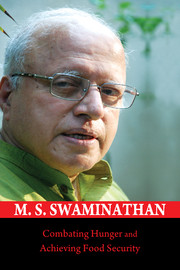Book contents
- Frontmatter
- Contents
- Foreword
- Preface
- Acknowledgements
- Abbreviations
- 1 Genesis and Growth of the Yield Revolution in Wheat
- 2 Our Agricultural Heritage
- 3 Shaping Our Agricultural Destiny
- 4 Thrust on Farm Revival
- 5 Nutri-farm Movement
- 6 Nutrition-sensitive Agriculture
- 7 Food Losses and Food Waste
- 8 Rice in Zero Hunger Challenge
- 9 Monsoon Management
- 10 Importance of Ecological Conservation
- 11 Caring for Ecology and Heritage
- 12 Conserving Biodiversity
- 13 Overcoming Hidden Hunger through Aquaculture
- 14 Biofuels – The Way to Go
- 15 Food Security
- 16 Vigilance for Sustainable Food Security
- 17 Food Security and Social Protection
- 18 Food Security and its Role
- 19 Sustaining the Livestock Revolution
- 20 Challenges in the Year of Science
- 21 Agriculture and Humanism
- 22 Fostering the Science of Science Communication
- 23 Olympic Move for Saving Children
- 24 Youth: The Agents of Change
- 25 Role of Women in Agricultural Production
- 26 Know-how to Do-how
- 27 From Bengal Famine to Right to Food
- 28 Financial Institutions and Fighting Food Inflation
- 29 Public Good Research in Agriculture
- 30 The Future of Indian Agriculture
- Bibliography
8 - Rice in Zero Hunger Challenge
Published online by Cambridge University Press: 18 December 2015
- Frontmatter
- Contents
- Foreword
- Preface
- Acknowledgements
- Abbreviations
- 1 Genesis and Growth of the Yield Revolution in Wheat
- 2 Our Agricultural Heritage
- 3 Shaping Our Agricultural Destiny
- 4 Thrust on Farm Revival
- 5 Nutri-farm Movement
- 6 Nutrition-sensitive Agriculture
- 7 Food Losses and Food Waste
- 8 Rice in Zero Hunger Challenge
- 9 Monsoon Management
- 10 Importance of Ecological Conservation
- 11 Caring for Ecology and Heritage
- 12 Conserving Biodiversity
- 13 Overcoming Hidden Hunger through Aquaculture
- 14 Biofuels – The Way to Go
- 15 Food Security
- 16 Vigilance for Sustainable Food Security
- 17 Food Security and Social Protection
- 18 Food Security and its Role
- 19 Sustaining the Livestock Revolution
- 20 Challenges in the Year of Science
- 21 Agriculture and Humanism
- 22 Fostering the Science of Science Communication
- 23 Olympic Move for Saving Children
- 24 Youth: The Agents of Change
- 25 Role of Women in Agricultural Production
- 26 Know-how to Do-how
- 27 From Bengal Famine to Right to Food
- 28 Financial Institutions and Fighting Food Inflation
- 29 Public Good Research in Agriculture
- 30 The Future of Indian Agriculture
- Bibliography
Summary
Mr Ban Ki-moon, Secretary General of the UN, launched the Zero Hunger Challenge at the Rio+20 Conference on Sustainable Development held in Brazil in June 2012. At a high level consultation held in Madrid in April 2013, it was agreed that the global community should commit to a common vision that hunger, food insecurity and malnutrition should be ended by 2025. At these meetings, governments were requested to pay concurrent attention to the following five pillars of the Zero Hunger Challenge:
• 100 per cent access to adequate food all year round;
• zero stunted children less than two years of age;
• all food systems made sustainable;
• 100 per cent increase in smallholder productivity and income; and
• zero loss or waste of food.
Each one of these pillars is relevant to the rice-growing regions of Asia. Taking food losses and food waste alone, it has been estimated that one-third of food production is lost or wasted globally, i.e., about 1.3 billion tonnes per year. In India, 100 per cent access to adequate food all year round can be achieved if the legal entitlements under the National Food Security Act reach those needing social protection against hunger. In spite of all the technological progress made, FAO estimates that 531 million people still suffer from chronic hunger in the Asia-Pacific region. This implies that about two-thirds of those who are hungry live in India. In addition, 100 million children under the age of 5 (or 28 per cent of the world total) were stunted in 2010 in the Asia-Pacific region. It is in this context that the role of rice farming systems in achieving the zero hunger goals has to be considered.
The world will require 50 per cent more rice in 2030 than in 2015 with approximately 30 per cent less arable land than now. It has been estimated that an additional 100 million tonnes will be required by 2035 in the Asia-Pacific region. The total production of rice in 2013 was 718 million tonnes. How can these challenges be met in countries where rice is the main staple?
First, in all irrigated areas the major emphasis should be on increasing yield per units of land and water. Hybrid rice can help increase yield by about 20 per cent.
- Type
- Chapter
- Information
- Combating Hunger and Achieving Food Security , pp. 47 - 52Publisher: Cambridge University PressPrint publication year: 2016



